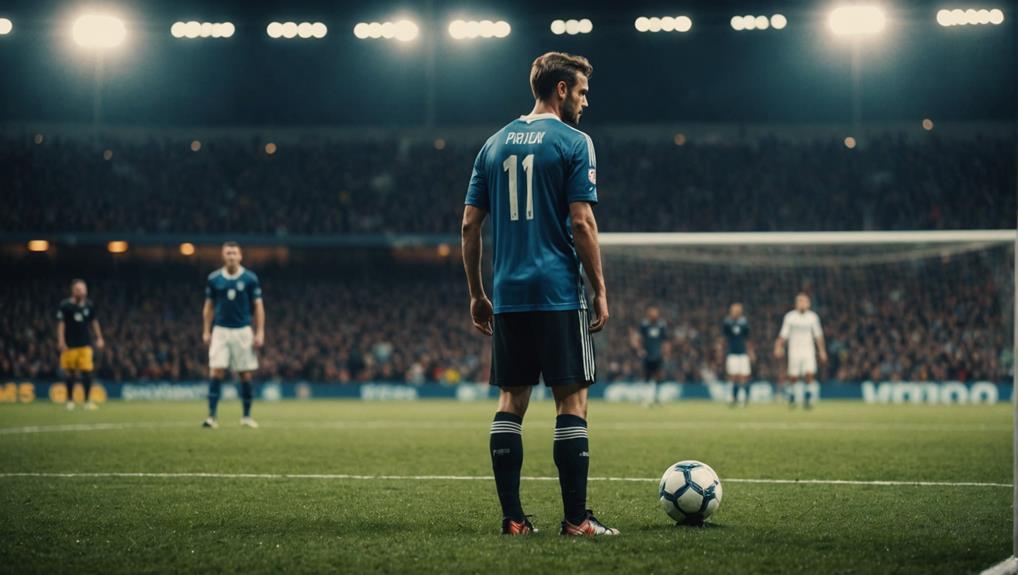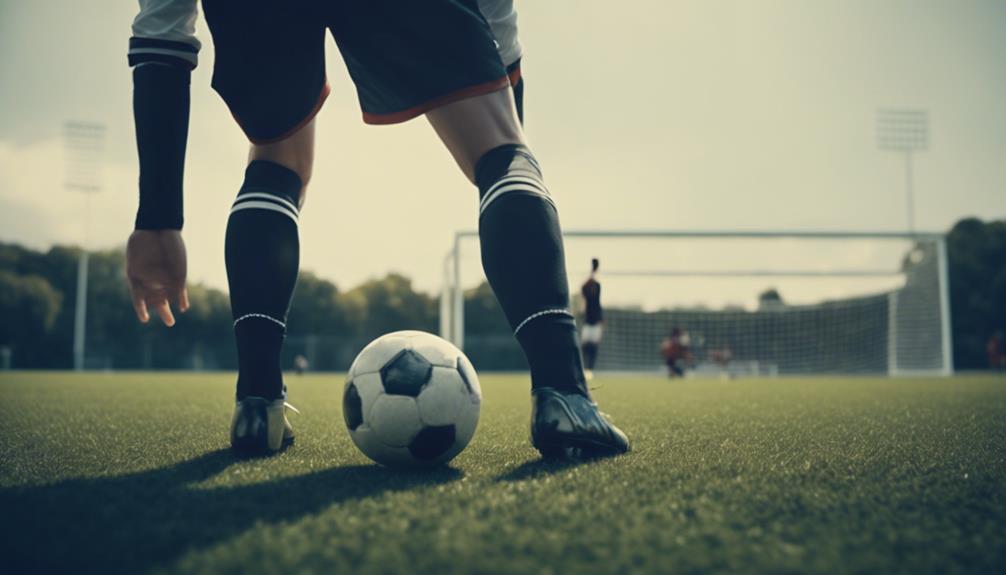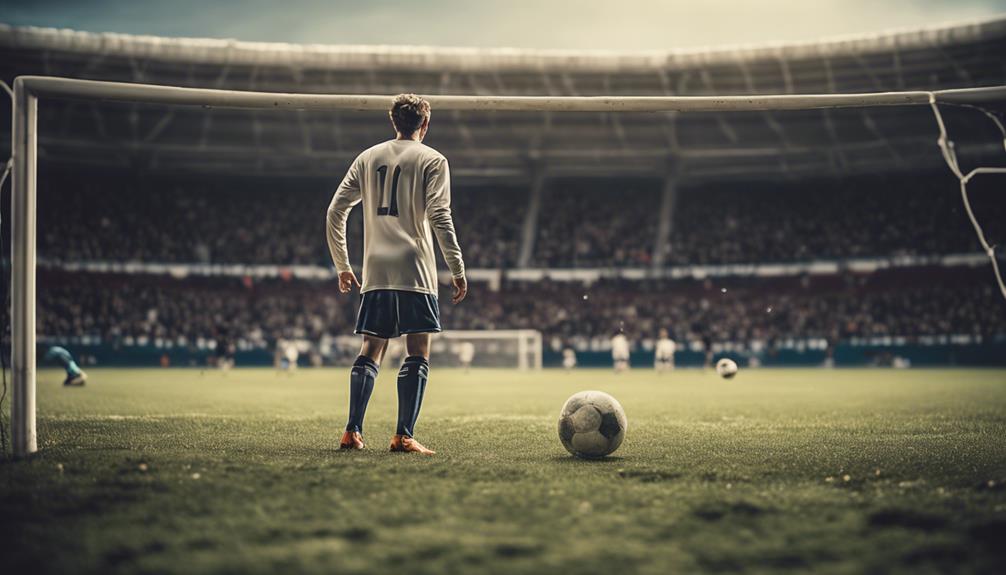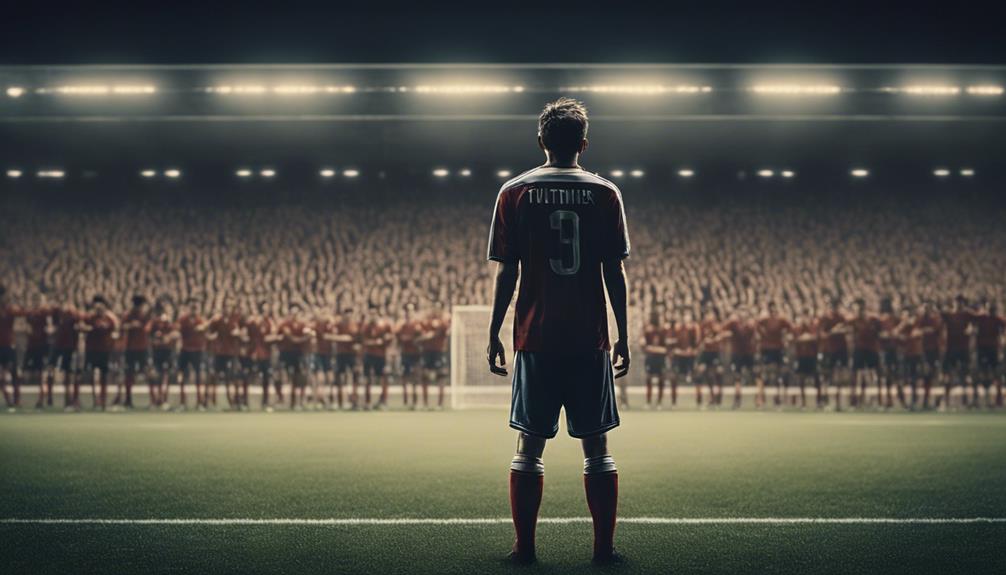
What Is a Free Kick in Soccer? Rules and Strategies
July 19, 2024In soccer, a free kick is an important opportunity for your team to score or defend effectively. Two main types exist: direct and indirect. Direct kicks let you shoot straight at the goal, while indirect kicks require a teammate's touch first. Understanding these differences is vital for your strategy. The process begins with the referee's signal, where your team must position tactically for the best chance at scoring. Utilize deceptive movements and quick passes to outsmart your opponents. Remember, mastering free kicks can give you a competitive edge on the field.
Types of Free Kicks
Direct free kicks and indirect free kicks are two main types of free kicks in soccer, each with distinct rules and requirements.
Direct free kicks are awarded for more serious fouls committed on the field, allowing the player to kick the ball directly into the goal without needing another player to touch it.
On the other hand, indirect free kicks are given for technical infractions and require the ball to be touched by another player before a goal can be scored.
The type of free kick, whether direct or indirect, is signaled by the referee based on the nature of the offense.
Understanding the differences between direct and indirect free kicks is essential for players to strategize and execute effectively during a match.
Direct Vs. Indirect
When comparing free kicks in soccer, the distinction between direct and indirect plays an essential role in determining the strategy on the field. Direct free kicks offer a prime opportunity for a player to shoot directly at the goal without needing another touch. These are typically awarded for more serious fouls like handballs or major offenses.
On the other hand, indirect free kicks require the ball to touch another player before a goal can be scored. These are usually given for technical infractions or non-penal fouls. Understanding the difference between direct and indirect free kicks is vital for effective strategy execution.
In direct free kicks, the player has the advantage of aiming straight at the goal, while in indirect free kicks, a strategic play involving a touch from another player is necessary to score. This disparity in execution impacts the team's strategy and approach to capitalize on the opportunities presented by free kicks during a game.
Free Kick Process

Now let's talk about the key points of executing a successful free kick.
You must focus on the execution, positioning, and the defensive wall during this critical set-piece moment.
Understanding these elements will enhance your ability to capitalize on free kick opportunities.
Execution of Free Kicks
To execute a free kick in soccer, the process is initiated by the referee signaling the foul and determining whether the kick is direct or indirect. Free kicks are typically taken from the spot of the foul, unless the offense occurs within the opponents' penalty area, resulting in a penalty kick from the penalty marker. Defensive players must maintain a distance of at least 10 yards from the ball during the free kick, with the exception of those on the defending goal line. The possession team selects a player to take the free kick, while teammates are allowed to position themselves as desired around the ball.
When setting up for a free kick, offensive players often employ various strategies to create scoring opportunities. These strategies can include deceptive movements to confuse the defensive wall or quick, unexpected passes to catch the opposition off guard. By carefully planning and executing free kicks, teams can effectively capitalize on these set-piece opportunities to gain an advantage in the game.
Positioning and Wall
During a free kick in soccer, the defending team must strategically position a wall of 3 or more players to impede the shot. The wall plays an important role in protecting the goal and minimizing the scoring opportunity for the opposing team.
Here are some key points to think about in the positioning and wall setup:
- The defending team's players create a barrier to obstruct the free kick taker's view.
- Players in the wall must maintain the required distance from the ball for a fair free kick execution.
- The wall aims to minimize the space available for the ball to pass through.
- Strategic positioning within the wall is essential to cover potential gaps and angles.
- The wall's coordination and solidarity are crucial in effectively defending against the free kick.
Defending Team's Wall
When setting up to defend a free kick in soccer, the defending team typically forms a wall of 3 or more players. This wall serves as a defensive barrier aimed at blocking the free kick taker's view, limiting scoring opportunities, and disrupting their accuracy.
Strategic positioning within the wall is vital as players aim to protect the goal and deflect the ball away from danger. Defensive tactics involve coordinating the wall effectively to guarantee proper coverage and maximize the chances of blocking or redirecting the incoming free kick.
Additionally, maintaining the required distance from the ball is essential, with attacking players mandated to stay at least 1 meter away until the ball is in play. By implementing these defensive strategies, teams can enhance their chances of successfully defending against free kick situations and thwarting the opposition's goal-scoring attempts.
Goal-Scoring Opportunities

As the defending team works to thwart goal-scoring opportunities during a free kick, the kicking team is presented with a direct chance to score without requiring another player's touch. Direct free kicks offer a unique opportunity for skilled free kick takers to showcase their abilities and potentially score pivotal goals that can impact the game's outcome greatly.
Here are some key points to ponder regarding goal-scoring opportunities from free kicks:
- Direct free kicks provide a direct path to shooting directly into the goal without needing a touch from another player.
- Indirect free kicks, on the other hand, necessitate the ball to touch another player before resulting in a goal.
- Free kicks are pivotal moments in a match, often leading to game-changing goals.
- Skilled free kick takers can turn these opportunities into pivotal goals that swing the momentum of the game.
- Direct goal-scoring opportunities from free kicks can be decisive in determining the final result of the match.
Free Kick Strategies
When taking free kicks, focus on your positioning to maximize your chances of scoring. Develop set-piece routines with your teammates to outsmart the opposition's defense.
Identify and exploit the weak spots in the defensive wall or goalkeeper's positioning to increase your chances of success.
Positioning for Free Kicks
Strategically positioning players is essential for maximizing scoring opportunities during free kicks in soccer. When setting up for a free kick, consider the following:
- Defensive Wall Formation: The opposing team constructs a defensive wall to block the path to the goal.
- Optimizing Scoring Opportunities: Proper positioning can create gaps in the wall or provide better angles for shots on goal.
- Maintaining Distance: Offensive players must stay a specific distance away from the ball until it's in play.
- Teamwork: Coordination among teammates is key to executing planned strategies effectively.
- Goal Path Blocking: The defensive wall's primary objective is to obstruct the free kick taker's view of the goal, reducing scoring chances.
Set-Piece Routines
Effective set-piece routines in soccer free kicks involve intricate pre-planned plays designed to create ideal goal-scoring opportunities. Teams employ various tactics such as decoy runs, precise passing routines, and strategic positioning to outsmart opponents during set pieces.
Utilizing wall defense is important to block the opposing team's view and protect against direct shots. Additionally, incorporating chip or curve kicks can surprise the goalkeeper and enhance the chances of scoring.
Designated free kick takers play a key role in executing set-piece routines with precision and power. Coaches meticulously plan set-piece tactics for both direct and indirect free kicks, aiming to exploit weaknesses in the opposition's defense.
To enhance execution, players invest in quality soccer cleats, use training mannequins for practice, and consistently work on their free kick techniques. By mastering set-piece routines, teams can greatly improve their goal-scoring opportunities and overall performance on the field.
Targeting Weak Spots
Identifying defensive weaknesses is essential when devising free kick strategies to maximize scoring opportunities on the field. To target weak spots effectively, consider the following strategies:
- Exploit gaps: Look for openings in the defending team's wall or gaps in the goalkeeper's positioning to aim your free kick accurately.
- Study opponents: Analyze past games to identify areas where the opponent has shown vulnerabilities to free kicks, allowing you to tailor your strategy accordingly.
- Deceptive runs: Use deceptive runs and dummy plays to confuse the defending team, creating space for a successful free kick.
- Varied routines: Practice different free kick routines and angles during training to keep opponents guessing and enhance your scoring chances during matches.
- Adaptation: Adjust your free kick strategies based on the opponent's defensive setup and reactions to previous set pieces, ensuring you stay one step ahead.
Free Kick Signal

When preparing to take a free kick in soccer, the referee's signal plays an essential role in determining the type of kick to be taken. For an indirect free kick, the referee raises their arm at a 45-degree angle. This signal indicates that the ball must touch another player before a goal can be scored.
On the other hand, for a direct free kick, the referee doesn't raise their arm, allowing the kicker to take a shot directly at the goal.
The positioning of the ball for the free kick is important, as it should be at the spot where the foul occurred. Defending players are required to be at least 10 yards away from the ball until it's in play.
The free kick signal helps players and spectators distinguish between direct and indirect free kick situations, ensuring everyone understands the type of kick to be executed. By following the referee's signals and understanding the rules, teams can effectively strategize and capitalize on free kick opportunities.
Scoring From a Free Kick
Understanding the rules for scoring from a free kick in soccer is key to maximizing your team's opportunities for goal scoring.
When taking a free kick, keep in mind the following:
- A goal can be scored directly from a free kick by aiming the ball into the opponent's goal, bypassing any touches from other players.
- Be cautious not to kick the ball into your own goal from a free kick, as it will result in a corner kick for the opposing team.
- In the case of an indirect free kick, remember that a goal can only be scored if another player touches the ball before it crosses the goal line.
- If an indirect free kick is successfully kicked into the opponent's goal without any other player touching it, a goal kick is awarded instead.
- Similarly, if an indirect free kick is misplayed into your team's own goal without another player making contact, a corner kick is granted to the opposing team.
Impact on Match Outcome

Effective free kicks can be game-changers, influencing the final result of a match greatly. The outcome of a game can hinge on a well-executed free kick, providing teams with important scoring opportunities.
Skillful players can convert free kicks into pivotal goals, shifting the momentum and deciding the match in their favor. Defending teams, on the other hand, employ strategies to thwart these scoring chances, maintaining their lead or seeking a comeback.
The role of the referee in ensuring fair play during free kicks is essential, as they enforce rules to prevent any unfair advantages.
Understanding and implementing effective free kick strategies can give a team a competitive edge, especially in tightly contested matches where every goal matters. Teams that capitalize on free kick opportunities showcase their prowess and ability to adapt tactically.
Mastering the art of free kicks not only adds to a team's arsenal but also plays a significant role in determining the outcome of matches.
Conclusion
In summary, mastering the art of free kicks in soccer can be a game-changer. Remember, practice makes perfect, so don't be afraid to put in the time on the training ground.
With the right technique and a bit of luck, you could be the one to 'bend it like Beckham' and score an important goal for your team.
So keep honing your skills and who knows, you might just become a free kick maestro!


